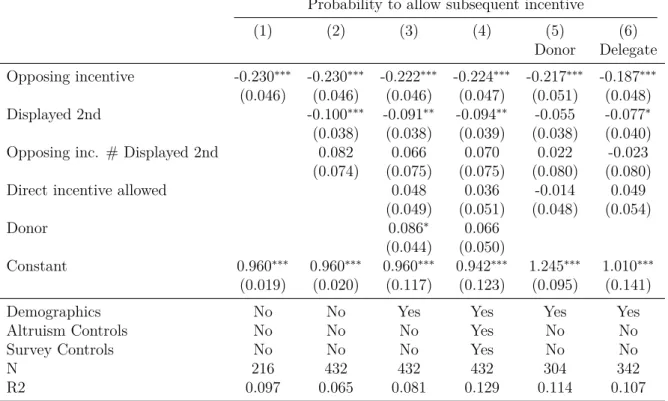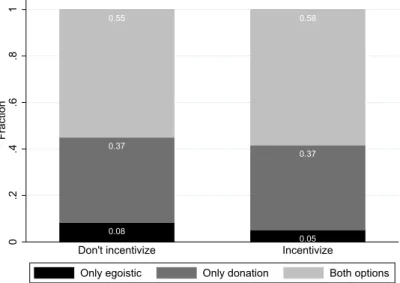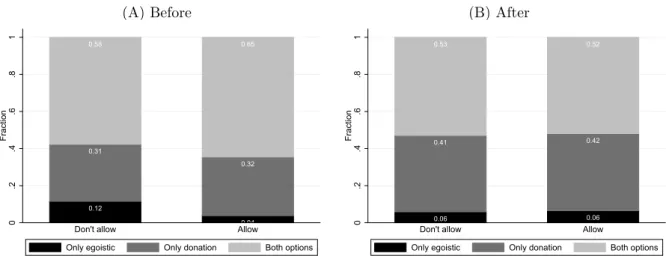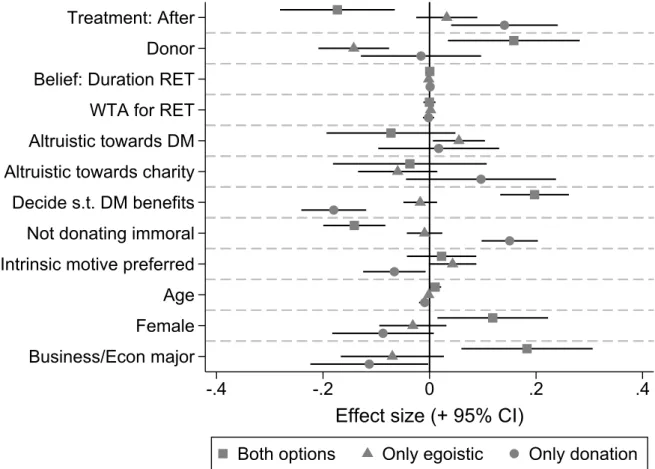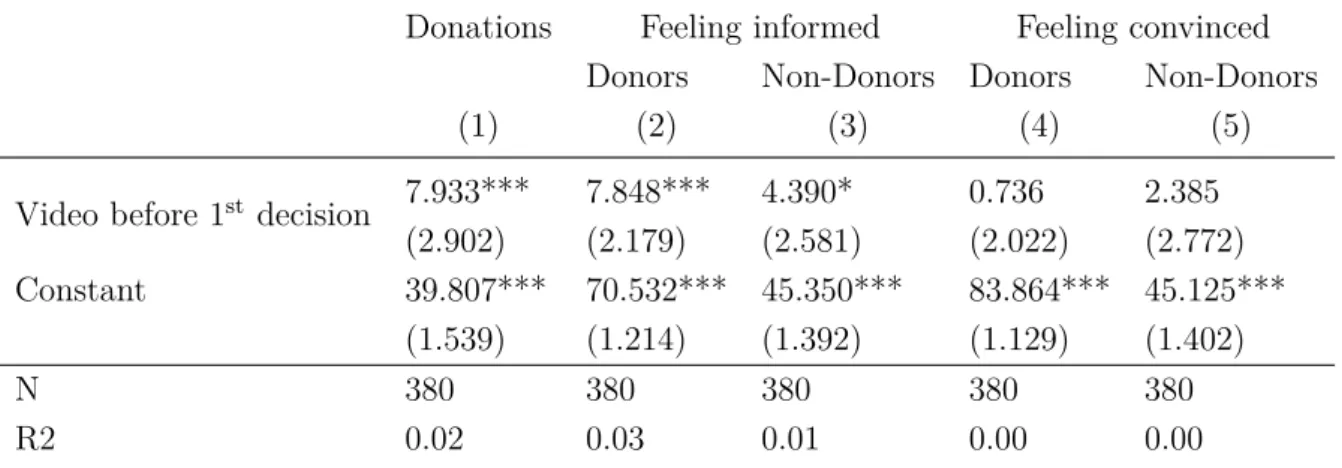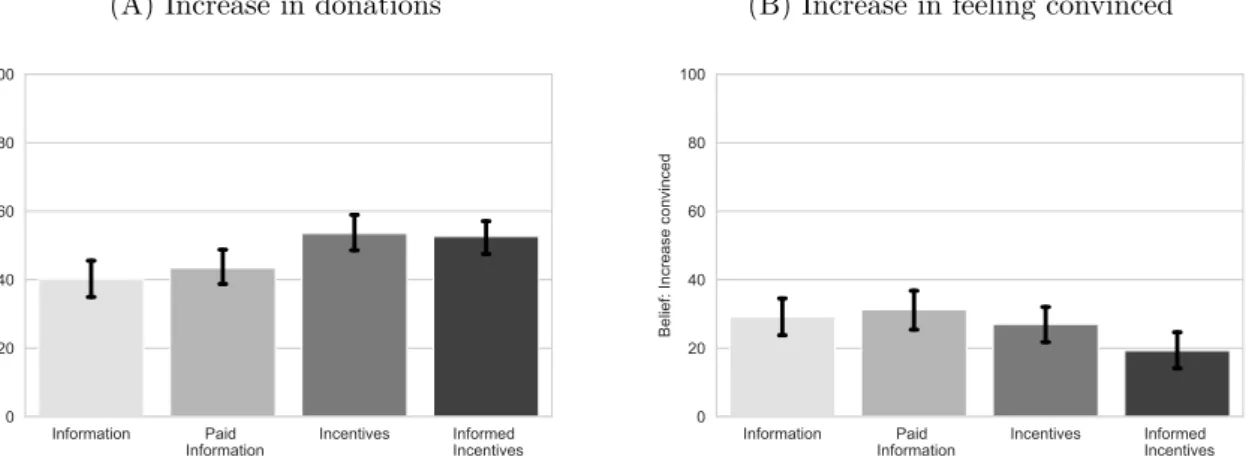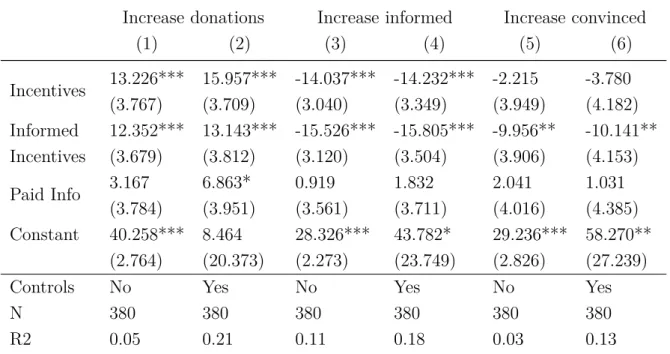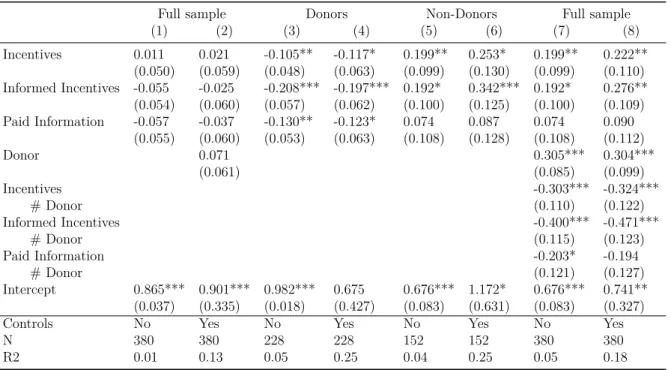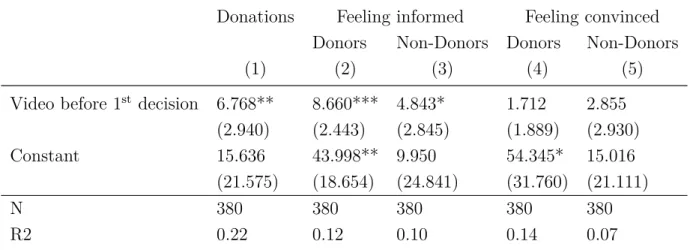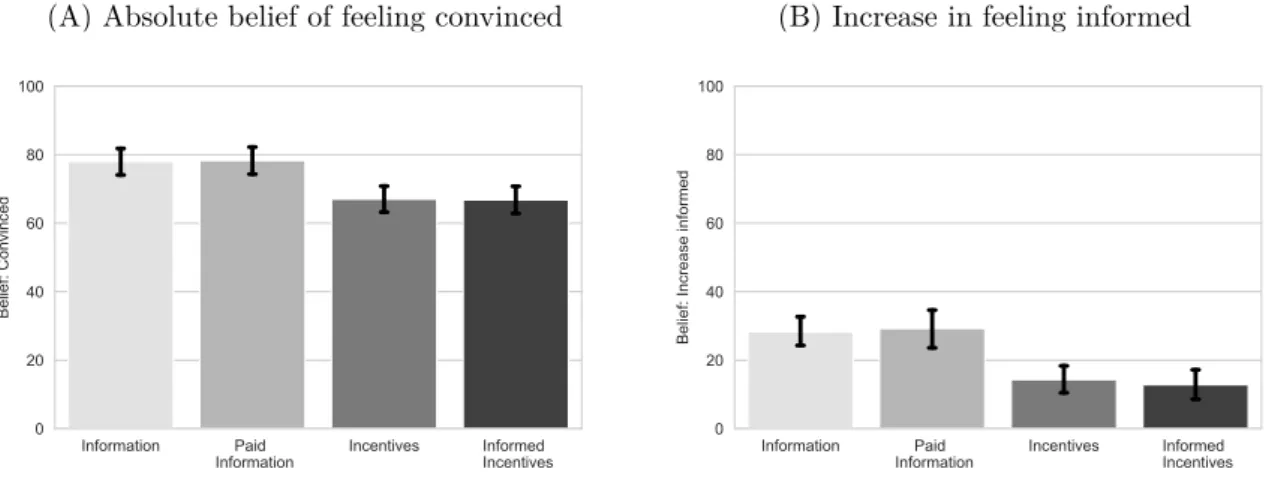Essays on Repugnance in Economic Transactions
Inauguraldissertation zur Erlangung des Doktorgrades der Wirtschafts- und Sozialwissenschaftlichen Fakultät
der Universität zu Köln
2020
vorgelegt von
Viola Sophia Ackfeld, M.Sc.
aus Hamm
Referent: Prof. Dr. Axel Ockenfels Korreferent: Prof. Dr. Matthias Heinz Datum der Promotion: 27.04.2020
Acknowledgments
I am grateful to my advisors Axel Ockenfels and Matthias Heinz for their continuous academic and personal support within the three and a half years of my dissertation. I benefited a lot from your insightful feedback. I am additionally thankful to Christoph Schottmüller for chairing my dissertation committee and for being very approachable for questions already during my dissertation phase.
My sincere gratitude goes to my coauthors Werner Güth, Axel Ockenfels, Tobias Rohloff, and Sylvi Rzepka. This dissertation would not have been possible without their fruitful input and the inspiring discussion we had.
I would like to thank my friends and / or colleagues at the chair and around, par- ticularly Anja Bodenschatz, Kevin Breuer, Rebekka Cordes, Kerstin Eilermann, Thomas Lauer, Lisa Lenz, Kiryl Khalmetski, Felix Kölle, Lea Petters, Uta Schier, Daria Tisch, Marius Vogel, and Lukas Wenner, for the pleasant and cooperative work environment.
In particular, I want to thank Anna Hartmann for being a close and supportive friend during the research track, when sharing an office, and afterwards during my whole Ph.D.
time. Additionally, I want to thank our student assistants at the chair, especially Kirsten Marx, for their support related to my dissertation projects.
I am grateful to the European Research Council (ERC) for funding my academic position as well as my research under the European Union’s Horizon 2020 research and innovation programme (grant agreement No 741409 - EEC). I thank the Cologne Graduate School in Management, Economics, and Social Sciences for a full-time Ph.D. scholarship in the first one and a half years of my dissertation. Additionally, I am thankful to the Joachim Herz Foundation for financing conference participations as well as my research stay at the University of California, San Diego, which would otherwise not have been possible. I also want to say thank you to Uri Gneezy for hosting me as a visiting Ph.D.
student at the Rady School of Management, University of California, San Diego.
Moreover, I want to thank my family for their support from early on and for filling me with enthusiasm for learning. Last but by no means least, I am indebted to Lukas not only for always being my first reference for any academic matter, but also for his personal support during all phases of my dissertation.
Contents
Introduction 1
1 Protecting Autonomy versus Intervening to Promote Prosocial Behavior 5
1.1 Introduction . . . . 6
1.2 Experimental Design . . . . 9
1.3 Results . . . . 15
1.4 Conclusion . . . . 26
1.A Appendix: Additional results . . . . 28
1.B Appendix: Experimental material . . . . 31
2 The Aversion to Monetary Incentives for Changing Behavior 51 2.1 Introduction . . . . 52
2.2 Experimental Design . . . . 57
2.3 Results . . . . 64
2.4 Conclusion . . . . 73
2.A Appendix: Additional results . . . . 76
2.B Appendix: Experimental material . . . . 80
3 Personal Information Disclosure under Competition for Benefits: Is Sharing Caring? 105 3.1 Introduction . . . 106
3.2 Literature . . . 109
3.3 Experimental design . . . 112
3.4 Results . . . 122
3.5 Discussion: Robustness of results based on beliefs . . . 137
3.6 Conclusion . . . 140
3.A Appendix: Additional results . . . 144
3.B Appendix: Instructions . . . 163 4 Increasing Personal Data Contributions: Field Experimental Evidence
from an Online Education Platform 167
4.1 Introduction . . . 168
4.2 Experimental set-up . . . 172
4.3 Empirical strategy . . . 177
4.4 Results . . . 179
4.5 Conclusion . . . 191
4.A Appendix: Additional results . . . 194
References IX
List of Tables
1.1 Descriptive statistics: Sample characteristics . . . . 16
1.2 Average marginal effects of allowing full/restricted choice set by treatment 18 1.3 Linear probability model: Use of incentives . . . . 22
1.4 Average marginal effects of allowing full/restricted choice set by allowance of Opposing incentive . . . . 25
1.A.1 Descriptive statistics: Decision-makers . . . . 28
1.A.2 Linear probability model of enforcing donation by treatment . . . . 28
2.1 Beliefs elicited regarding donation rate, information level, and feeling convinced . . . . 61
2.2 Descriptive statistics: Sample characteristics . . . . 65
2.3 OLS regression results regarding judges’ pre-intervention beliefs . . . . . 66
2.4 OLS regression results regarding judges’ post-intervention beliefs . . . . . 69
2.5 Linear probability model of likelihood to intervene by treatment . . . . . 72
2.A.1 OLS regression results regarding judges’ pre-intervention beliefs with con- trols . . . . 76
2.A.2 Regression results regarding judges’ pre- and post-intervention beliefs - Only donors . . . . 76
2.A.3 Marginal effects from probit and logit models of likelihood to intervene by treatment . . . . 79
3.1 Questionnaire . . . 114
3.2 Treatments: Two-by-two factorial design . . . 118
3.3 Descriptive statistics: Sample characteristics . . . 123
3.4 Effect of strategic incentives on ex ante disclosure . . . 125
3.5 Ex post disclosure changes by treatment . . . 127
3.6 Perceived pressure to disclose information by treatment . . . 131
3.A.1 Descriptive statistics: Outcome variables . . . 144
3.A.2 Probit regressions - Disclosure-affecting factors at question level . . . 146
3.A.3 Tobit regressions - Effect of strategic incentives on ex ante disclosure . . 147
3.A.4 Robustness to winsorization - Ex ante disclosures and ex post disclosure
changes . . . 148
3.A.5 Relevance and discomfort of ex post disclosure changes by treatment . . 149
3.A.6 Adaptations to competitor and directions of ex post disclosure changes . 150 3.A.7 Answer scores by more / less initial disclosure on question level . . . 151
3.A.8 Perceived answer score differences by more / less initial disclosure on question level . . . 152
3.A.9 Effect of difference in information disclosure on probability to become allocator . . . 153
3.A.10 Payoff if determined by oneself or allocated by competitor . . . 155
3.A.11 Payoff allocations by treatment and disclosure behavior . . . 156
3.A.12 Payoff allocations by treatment and relevant disclosure behavior . . . 158
3.A.13 Acceptance thresholds by role and treatment . . . 160
3.A.14 Robustness to winsorization - Perceived pressure and allocation behavior 160 3.A.15 Effects of answers and disclosures on selection and allocation behavior . . 162
4.1 Wording of treatments . . . 175
4.2 Pre-intervention course activity and characteristics overall and by treat- ment . . . 180
4.3 OLS regression results of main outcomes on treatment . . . 183
4.4 OLS regression results of further outcomes by treatment . . . 187
4.5 Marginal effects of multinominal logit regressions regarding pre-post shifts in profile content distributions by treatment . . . 189
4.A.1 OLS regression results of further outcomes with controls by treatment . . 195
4.A.2 OLS regression results of disclosing any (in)sensitive entry on treatment . 196 4.A.3 OLS regression results: Heterogeneity by treatment . . . 197
4.A.4 Content of pre-intervention profile entries . . . 201
4.A.5 Marginal effects of multinominal logit regressions regarding pre-post shifts in profile content distributions . . . 202
List of Figures
1.1 Structure of the experiment . . . . 10
1.2 Use of bans overall and by treatment . . . . 17
1.3 Coefficient plot: Use of incentives . . . . 21
1.4 Use of bans by use of Opposing incentive . . . . 24
1.A.1 Use of bans overall and by treatment . . . . 29
1.A.2 Relationship between bans and incentives by timing of ban implementation 29 1.A.3 Coefficient plot of factors significantly affecting the use of bans . . . . 30
1.B.1 Decision screen judges: Bans Before treatment . . . . 31
1.B.2 Decision screen judges: Bans After treatment . . . . 31
1.B.3 Decision screen judges: Opposing incentives treatment . . . . 32
1.B.4 Decision screen judges: Aligned incentives treatment . . . . 32
1.B.5 Decision screen judges: Direct incentives treatment . . . . 33
1.B.6 Decision screen decision-makers: Bans Before treatment . . . . 33
1.B.7 Decision screen decision-makers: Bans After treatment . . . . 33
1.B.8 2nd decision screen decision-makers: Opposing incentives treatment . . . 34
1.B.9 2nd decision screen decision-makers: Aligned incentives treatment . . . . 34
1.B.10 Decision screen decision-makers: Direct incentives treatment . . . . 34
2.1 Structure of the laboratory experiment . . . . 58
2.2 Bar plots of judges’ beliefs regarding increases in donations and in feeling convinced by treatment . . . . 68
2.3 Bar plots of intervention behavior by treatment . . . . 70
2.A.1 Bar plots of judges’ beliefs of feeling convinced (absolute) and increase in feeling informed after intervention by treatment . . . . 77
2.A.2 Bar plots of judges’ beliefs regarding increase in feeling convinced by treatment and intervention decision . . . . 78
2.A.3 Bar plots of intervention behavior of non-donors by treatment . . . . 78
2.B.1 Decision screen judge: Incentives and Informed Incentives treatments . . 80
2.B.2 Decision screen judge: Information treatment . . . . 80
2.B.3 Decision screen judge: Paid Information treatment . . . . 81
3.1 Structure of the experiment . . . 113
3.2 Histograms of answers ex ante disclosed . . . 124
3.3 Coefficient plots of ex post disclosure changes by treatment . . . 126
3.4 Coefficient plot of perceived pressure to disclose by treatment . . . 130
3.5 Probability of becomingallocator by difference in information disclosure 133 3.6 Coefficient plot of money allocated to C by information disclosure and selection . . . 135
3.7 Disclosure behavior and beliefs by treatment and ex ante disclosure . . . 138
3.A.1 Histograms of answers . . . 145
3.A.2 Coefficient plot of acceptance thresholds by role and treatment . . . 159
4.1 Timeline of the experiment . . . 174
4.2 Extensive Margin: Increase in fraction of users with any profile entry by treatment . . . 182
4.3 Intensive margin: Increase in number of profile entries by treatment . . . 184
4.4 Participants who click on profile link by treatment . . . 185
4.A.1 Screenshot of interventional pop-up message . . . 194
4.A.2 Increase in number of old profile entries by treatment . . . 194
4.A.3 Histograms of profile entry content before and after the intervention . . . 200
Introduction
The efficient exchange of goods and services is the core theme of economics and has been extensively studied for decades. However, with respect to some repugnant types of goods like organ and blood donations, personal data, or CO2 emissions, there seems to exist an aversion to trade these goods at all or at least if money is involved. As Nobel Laureate Al Roth emphasizes, “distaste for certain kinds of transactions can be a real constraint [. . . ], every bit as real as the constraints imposed by technology or by the requirements of incentives and efficiency” (Roth 2007, p. 38).
In this thesis, I study situations of economic exchange in terms of their ethical accept- ability. Particularly, I investigate the scope and limits of social and monetary incentives by means of experiments in lab, online, and field settings. In the first two chapters, I look at what conditions make people refrain from fostering the implementation of their favored outcome for others. More precisely, I examine people’s willingness to intervene in others’
decision-making by monetary incentives along with choice-prescribing bans (Chapter 1) or along with information (Chapter 2). My results demonstrate that the perseverance of others’ autonomy to decide for themselves (Chapter 1) as well as people’s aversion to make others do something which the latter are not convinced of (Chapter 2) play an important role when judging the acceptability of economic interventions. In Chapters 3 and 4, I zoom in on one particular good, whose trade may be considered as repugnant, namely the sharing of personal data, and investigate issues with personal data sharing. In Chapter 3, I point out that personal data disclosure competition in modern online mar- kets with both social comparison and high incentives for information sharing can increase information available in the economy, but may come along with a hidden cost of perceived pressure on disclosure-unwilling individuals with high privacy concerns. Focusing not on competition via personal information disclosure but on personal data as contributions to a public good, Chapter 4 highlights that making privacy protection salient together with public benefits may increase personal data contributions to a public good. Taken
together, the four chapters of my thesis highlight important ethical but yet economically underesearched issues that have to be taken into account when designing new forms of economic exchange.
In what follows, I provide a short overview of each of the four chapters. In Chapter 1, titled “Protecting Autonomy versus Intervening to Promote Prosocial Behavior”, which is joint work with Axel Ockenfels (University of Cologne), we investigate people’s willingness to intervene in others’ prosocial decision-making in light of a trade-off between promoting prosocial behavior and protecting the affected party’s autonomy to decide for herself.∗ In an experiment, in which one group of participants determines the experimental rules for another group of participants within an charitable donation paradigm, we find that a majority of subjects who would donate to charity themselves refrains from interfering at all with others’ autonomous charitable decision-making. People who intervene perceive interventions - which correspond to choice-prescribing bans and monetary incentives in the experiment - as more acceptable to promote prosocial behavior the more the interven- tions respect the autonomy of affected parties. More precisely, choice-prescribing bans are preferred if they first grant a feeling of perceived autonomy to let others decide for them- selves, and monetary incentives prevail less acceptable if they are implemented against instead of aligned with one’s own previous wants.
Chapter 2 studies an aversion to monetary incentives to make other people change their behavior and is accordingly called “The Aversion to Monetary Incentives for Chang- ing Behavior”. I provide evidence that monetary incentives are disliked because they are powerful in changing what people do but not why they do it besides for money. In an experiment, one group of participants decides about interventions which try to change others’ behavior such that the latter donate to charity. I vary between treatments whether subjects can intervene by means of convincing information or monetary incentives. In ad- ditional treatments, the intervention corresponds to monetary incentives for subjects, who already received information, or of incentivizing information acquisition. While partici- pants consider monetary incentives as more effective in changing behavior than informa-
∗Both authors contributed equally to this project. They invented the research question and the experimental design together. Viola Ackfeld planned and conducted the experiment, analyzed the data, and prepared the first draft. Both authors wrote the final version of the paper together.
tive interventions, they are still less willing to intervene by monetary incentives compared to informative interventions to foster their preferred outcome, especially if people already made an informed decision. A comprehensive set of elicited beliefs supports the idea that this aversion to incentives stems from incentives’ lack of changing one’s reason to act.
Chapter 3 is named “Personal Information Disclosure under Competition for Benefits:
Is Sharing Caring?” and is joint work with Werner Güth (LUISS Rome and Max Planck Institute for Research on Collective Goods).† In this paper, we investigate monetary in- centives and social comparisons with other people’s information sharing as motives for extensive personal information sharing. Moreover, we study consequences thereof. More precisely, in an experiment, we analyze the interaction of peer comparison and incentives to disclose potentially privacy-sensitive information. We find that information sharing is higher under incentives and further increases with additional peer comparison. In- dividuals, who initially disclose less information, react the most to the combination of incentives and social comparison, but also report to feel more compelled to disclose infor- mation. While increasing the availability of information, reliance on extensive information sharing does not prevail as a useful device to screen prosocial types. Our results provide an explanation for the current information-sharing trend, but also point to potentially neglected side effects of extensive personal information sharing.
The last chapter is called “Increasing personal Data Contributions: Field Experimental Evidence from an Online Education Platform” and is joint work with Tobias Rohloff (Hasso Plattner Institute and University of Potsdam) and Sylvi Rzepka (University of Potsdam).‡ In this paper, we study personal data sharing as a contribution to a public good. In a field experiment on an online education platform, users are prompted to complete their user profiles. We examine whether public good contributions in form of personal data increase when varying the salience of public benefits and perceived privacy
†Both authors contributed equally to this project. They invented the research question and the experimental design together. Viola Ackfeld planned and conducted the experiment, analyzed the data, and prepared the draft. Werner Güth gave feedback on the draft.
‡All authors contributed equally to this project. Sylvi Rzepka and Viola Ackfeld developed the research question and the experimental design together. Tobias Rohloff implemented the experiment on the online platform and provided the necessary data. Viola Ackfeld analyzed the data. Sylvi Rzepka gave feedback on the statistical analysis. After Viola Ackfeld prepared the first draft of the paper, Viola Ackfeld and Sylvi Rzepka wrote the final version of the paper together. Tobias Rohloff gave feedback on the draft.
costs. Relative to a control message, we find that salience of the public benefits increases the number of contributed profile information. This effect further increases when adding a reference to privacy protection. However, we do not find proof that such treatments can also motivate users, who initially do not provide any personal data, to start contributing.
These results highlight that even in a fast-paced environment like an online platform, reference to the social benefit may increase people’s willingness to contribute personal data, but primarily for those who are somewhat willing to share such information.
Taken together, the results in all four chapters of this thesis contribute to a better understanding of ethical factors that influence economic decision-making and the scope and limits of social and monetary incentives. While insights from psychology and sociology have made their way into economic research via behavioral economics in the last decades, the inclusion of ethical aspects is still rare. This thesis highlights that including insights from the ethics literature can improve our understanding of decision-making further and prepares the ground for a new direction of interdisciplinary research.
Chapter 1
Protecting Autonomy versus Intervening to Promote Prosocial Behavior
∗joint with Axel Ockenfels
Abstract
We experimentally investigate people’s willingness to intervene in others’ prosocial decision-making when facing a trade-off between promoting prosocial behavior and protecting the affected party’s choice autonomy. We find that a majority of subjects who would give for charity themselves refrain from interfering at all with others’
autonomous charitable decision-making. For those who intervene, the interventions – bans and monetary incentives – are more acceptable to promote prosocial behavior the more the interventions respect the autonomy of others.
∗This project has received funding from the European Research Council (ERC) under the European Union’s Horizon 2020 research and innovation programme (grant agreement No 741409 - EEC). Ackfeld acknowledges additional support from the Joachim Herz Foundation via an Add-On Fellowship for In- terdisciplinary Economics. Further support of the Deutsche Forschungsgemeinschaft (DFG) is gratefully acknowledged. The project was approved by the Ethics Review Board (ERB) of the Faculty of Man- agement, Economics, and Social Sciences, University of Cologne, and by the European Research Council Executive Agency (ERCEA) under the working title “Unwanted Circumstances for Doing Good”. We thank Kiryl Khalmetski, Felix Kölle, and audiences in Cologne and at CCBE Tel-Aviv for helpful com- ments. All views are the authors’ own.
1.1 Introduction
The question which interventions increase prosocial behavior has gained much attention in empirical economic research (see for example Andreoni (2015) and Lacetera et al. (2013) for reviews on how to increase charitable fundraising and blood donations, respectively).
However, the question which interventions are “acceptable” has gained much less atten- tion. In this paper, we investigate which interventions third-parties are willing to use in order to influence others’ prosocial behavior. In particular, we study a trade-off between promoting prosocial behavior and interfering with the affected party’s autonomy to de- cide for himself. According to scholars in philosophy, autonomy – freedom from external control or influence – possesses a non-instrumental, inherent value, which should be re- spected (Feinberg 1978; Rawls 1971, 1980; Young 1982). Previous research in behavioral economics has shown that autonomy may affect economic outcomes (Bartling et al. 2012;
Benz and Frey 2008; Cassar and Meier 2018; Fehr et al. 2013; Leider and Kessler 2016).
Thus, a demand for autonomy may limit the acceptability of interventions to promote social behavior.
In this paper, we consider two kinds of interventions, for which this trade-off is partic- ularly strong:1 bans that remove the selfish option and thus directly enforce the prosocial action, and monetary payments incentivizing the prosocial action. While bans are effec- tive, they leave no room for autonomous choice. In contrast, monetary incentives allow choice, but still may stand in conflict with some notion of autonomy – if trying to dissuade people from the choice they would have made without being incentivized (Grant 2006, 2011).
In our study, we let participants in an online experiment, called judges, decide about the rules that other participants in a subsequent lab experiment, called decision-makers, face. The former decide whether to use bans and incentives to channel the latter’s choice between a charitable donation of 10€, which yields only a small payoff of 3€ for the decision-maker, and a large payoff of 10€ for the decision-maker that precludes, however, the donation. Each donation finances an eye surgery against blinding in Ethiopia. Judges
1A third interventional tool to consider would be nudges (Thaler and Sunstein 2008). However, nudges are a rather soft form of intervention, not affecting one’s choice menu, so they do not create an equally strong trade-off between autonomy and outcomes.
can first either take away one of the two choice options from the decision-maker or leave his choice set unaffected. We vary whether the decision-maker is informed about the judge’s decision before or after he made his own choice. While the former leaves no room for the decision-maker to make a choice himself, the latter grants autonomy for doing good, but may still subsequently alter the outcome in case the donation is not chosen. In a second decision, judges can offer those decision-makers who initially chose to be selfish an additional private bonus of 2€ if they change their decision into a donation. In a control treatment, the bonus is offered to those choosing the donation anyway.
Suppose a judge values a dollar for the charity higher than a dollar for herself (and thus would donate herself), yet values a dollar for herself higher than a dollar for the decision- maker (a reasonable assumption if judges and decision-makers are randomly drawn from the same subject population). Then, if the autonomy of the decision-maker is irrelevant for the judge, this judge should be willing to use bans and incentives to promote a donation.
However, we find that more than half of the judges who donate themselves do not intervene at all. Among those judges who intervene, we observe that bans are more acceptable if the decision-maker is informed about the intervention only after he made his choice and the intervention only comes into effect in case the choice is inconsistent with the ban. Monetary incentives are more acceptable if the incentive is not used to dissuade a decision-maker who previously decided not to donate. We interpret this overall pattern of interventions as evidence for many judges respecting the decision-makers’ demand for autonomy. Moreover, our data suggest that while judges dislike to incentivize decision- makers to act “against their own will”, subsequently banning preferred outcomes does not seem to raise much concerns. Indeed, we do not find a statistical relationship between subjects’ willingness to use bans and incentives to influence others’ donation behavior on the individual level, which reinforces our view that judges do not only care about outcomes, but also about the decision process by which this outcome is reached. Different interventions may therefore be perceived differently threatening to autonomy.
Our paper is related to several interdisciplinary strands of literature. Autonomy is an important concept in philosophy. Besides its instrumental value of enabling people to decide for themselves, scholars also attribute a non-instrumental, inherent value to it
(Feinberg 1978; Rawls 1971, 1980; Young 1982). Additionally, autonomy together with relatedness and competence is a key component in self-determination theory (Deci and Ryan 1985; Ryan and Deci 2000) in psychology to motivate people, generating actions of superior quality than under extrinsic rewards like money (Lepper et al. 1973; Lepper and Greene 1978; Titmuss 1970). Recent economic research supports both empirically and theoretically that intrinsic motivation matters (Bénabou and Tirole 2003, 2006; Bowles and Polania-Reyes 2012; Frey and Oberholzer-Gee 1997). In the context of prosocial activities, Ashraf et al. (2014) and Gneezy and Rustichini (2000b) find that paying sub- jects for charitable fundraising activities decreases effort. When looking at autonomy in particular, there is laboratory evidence that people reduce their effort when experiencing more control and thereby less autonomy (Bartling et al. 2012; Fehr et al. 2013). Leider and Kessler (2016) highlight that this negative reaction to control stems from procedu- ral fairness concerns being violated. Similarly, using survey data, Benz and Frey (2008) show that self-employed people seem to gain procedural utility from being able to decide autonomously. While the conflict of bans with autonomy is rather obvious, incentives conflict with autonomy according to political scientist Grant (2006, 2011) insofar that they do not respect a choice an individual, capable of making moral choices, makes on his own. According to Grant, incentives may therefore be considered as a form of power trying to change one’s own decision. This may lead to a decision “against own better judg- ment” which interferes with autonomy. We provide empirical support for the importance of autonomy in decision-making along those lines.
With reference to research on philantrophy, there are many different attempts like matching donations (Eckel and Grossman 2003; Huck and Rasul 2011; Huck et al. 2015;
Meier 2007), seed money and refunds (List and Lucking-Reiley 2002) or peer comparison (Meer 2011) to increase charitable giving. See Andreoni (2015) for a collection of influen- tial papers. Similarly, several studies test monetary as well as non-monetary incentives to increase blood (Goette and Stutzer 2008; Lacetera and Macis 2010, 2013; Lacetera et al.
2014) as well as organ donations (Eyting et al. 2016; Kessler and Roth 2012; Mellström and Johannesson 2010). Our project extends this research by looking at third-parties’
willingness to intervene into others’ prosocial decision-making. While Jacobsson et al.
(2007) look atwhat kind of donations people prefer to give to others, in their case in-kind rather than monetary donations, our focus lies on the interventional tool people use to channel the donation behavior of others in light of its conflict with autonomy.
We investigate the trade-off between promoting prosocial behavior and granting others choice autonomy by looking at third-parties’ willingness to use bans and incentives as two forms of interventions to influence the prosocial behavior of others. From a methodological perspective, our experimental design overlaps with studies deploying so-called spectator designs (Almas et al. Forthcoming; Cappelen et al. 2013) to investigate third-parties’
willingness to intervene into others’ outcomes, most often in redistribution settings. In a setting with time-delayed payments, Ambuehl et al. (2019) use a related design to study paternalistic interventions into others’ choice set and find substantial intervention rates. Taking the perspective of third-parties into account is important because only investigating what works to increase prosocial behavior ignores that some tools may not be considered as acceptable (similar to repugnance in the domain of organ or blood donations (Roth 2007, 2018)). We provide evidence that many subjects are not willing to intervene at all to promote charitable giving, and that those who are willing seem to value and try to preserve the affected parties’ choice autonomy. Moreover, we contribute new insights that the perceived appropriateness of incentives substantially diminishes if they are used as a means to dissuade people from their previous, autonomous choice. This supports the concerns raised by Grant (2006, 2011) that incentives can constitute a threat to autonomy.
The rest of the paper is structured as follows. In section 1.2, we present our ex- perimental design. Section 1.3 presents and discusses the results, while the last section concludes.
1.2 Experimental Design
Our experiment consists of an online experiment and a laboratory experiment. Par- ticipants in the online experiment, henceforth called judges, can set the rules for the subsequent laboratory experiment, thereby determining the choice sets and payoffs of lab participants, calleddecision-makers. In what follows, we refer to a judge as “she” and to decision-maker as “he”. Figure 1.1 depicts the structure of the experiment. Screenshots
Figure 1.1: Structure of the experiment Online: Judges
Instructions
Allowance of choice options (A, B, or both):
Participant is informed about allowed options Before choice 50% After choice 50%
Allowance of incentive: add 2€ when donating a) ifopposing own choice 33%
b) if aligned with own choice 33%
c) directly before any choice 33%
MPL, incentivized beliefs, own choice Post-experimental questionnaire
Lab: Decision-makers Instructions Real effort task:
Count "4" in block of numbers, 40x
Payoff choice conditional on treatment and judge’s decision Post-experimental
questionnaire 50%
50%
random order
Notes: Probabilities reported as %. Treatment differences in italics. MPL refers to the multiple price lists for constructing altruism controls.
of how treatment differences are implemented as well as instructions for both parts of the experiment can be found in Appendix 1.B.
Laboratory experiment
Decision-makers in the laboratory experiment first have to fulfill a real-effort task, and can choose between two payoff alternatives afterwards. The real-effort task consists of correctly counting how often the number "4" is included in a block of numbers, and is repeated 40 times. An example for such a counting task can be found in the instructions in Appendix 1.B.2. The task is a version of that used in Abeler et al. (2011), generates no value for the experimenter nor pleasure for subjects completing it, but requires costly effort, which in turn might increase the subjects’ perception of entitlement to a larger payoff.
After finishing the real-effort task, decision-makers can pick one of two payoff alterna- tives. They can choose between receiving a payoff of 10€ without donating money (option A), and receiving a payoff of 3€ while donating 10€ to the German charity “Menschen für
Menschen” (option B). The donation finances an eye surgery in Ethiopia against blinding from the disease trachoma, the world’s most common bacterial reason for blindness. We show pictures of the surgery and provide details regarding the causes and consequences of the disease in the instructions. We inform participants that we are going to upload donation receipts on our website after the experiment. After the payoff choice is made, the laboratory experiment ends with a brief post-experimental questionnaire.
Online experiment
Judges in the online experiment determine the rules for the laboratory experiment. Their own payoff for participation is 4€ plus some bonus options as explained below, and does not relate to their decisions (not) to intervene. Since we recruit more judges than decision-makers, we randomly draw whose judges’ decisions are implemented, and then match each of these judges to one decision-maker. Judges make two kinds of decisions which are implemented with 50% probability each. The first decision concerns the choice set of decision-makers. Judges can choose between allowing both options A and B, thereby letting the decision-maker choose the outcome himself, or limiting his choice set to the egoistic option only (option A), or the donation option only (option B), respectively.
Suppose a judge values a dollar for the charity higher than a dollar for herself (and thus would donate herself), yet values a dollar for herself higher than a dollar for the decision-maker. Then, if the autonomy of the decision-maker is irrelevant for the judge, this judge would use her tools to promote a donation. Moreover, even if a judge would for herself selfishly decide against a charitable donation, she might value a donation to the charity higher than the decision-maker’s payoff and thus enforce charitable giving by the decision-maker. On the other hand, if judges respect the decision-makers’ autonomy, they may abstain from an intervention even if they donate themselves. This leads us to the following hypotheses.
Hypothesis 1a (Selfish intervention): Judges use bans to enforce charitable giving, in particular if they would donate themselves.
Hypothesis 1b (Autonomy): Judges do not use bans to enforce charitable giving, even if they donate themselves.
We randomly assign subjects into two treatments. In theAfter treatment, the decision- maker makes a choice and learns afterwards whether this choice is allowed by the judge matched to him.2 If it is allowed, it is implemented. Otherwise, it is overridden by the other option, the only one which the judge allowed, which is then implemented. In the Before treatment, options not allowed are already blanked out on the choice screen of the decision-maker so he does not have to make a choice at all. In contrast, in the After treatment, any interference only emerges after the decision-maker had the opportunity to do good himself, and only if he decided in misalignment with what his matched judge allowed. In that sense, in the After treatment, judges can let decision-makers first decide on their own, preserving a feeling of autonomy for the donation-willing individuals, and at the same time enforce the prosocial outcome for those who are not willing to donate.
Preserving a feeling of autonomy is not possible in the Before treatment. This leads us to our second set of hypotheses.
Hypothesis 2a (Outcome-based judgment): Judges use bans equally often in the Before and After treatment.
Hypothesis 2b (Preserving perceived autonomy): Judges use bans less often in the Be- fore than in the After treatment.
An alternative hypothesis is that choice is regarded by judges as a burden rather than an opportunity (as pointed out by Heath and Tversky (1991), Loewenstein (1999), Sunstein (2014, 2015), and Tversky and Shafir (1992)), and judges may want to altruis- tically free decision-makers from such a burden. In this case, we might see the opposite relationship between treatments.
Hypothesis 2c (Unburdening from choice): Judges use bans more often in the Before than in the After treatment.
The second decision that judges make concerns whether or not the decision-maker should get a 2€ extra incentive which is added to the decision-maker’s private payoff
2Whenever a decision-maker makes a choice, he knows that another participant has previously deter- mined the rules for the lab experiment, but does not know what particular choice is affected and how.
Importantly, he does not know that his choice may be overridden or that there may be the possibility to revise his choice.
if he donates. If used, the decision-maker’s own payoff from option B increases from 3€ to 5€. Here, judges have to make three within-subject decisions out of which one is randomly chosen and implemented with equal probability. They have to decide about an Opposingincentive, anAligned incentive, and aDirect incentive. We consider an incentive asOpposing if it is offered to the decision-maker for donating after he initially decided not to donate, i.e., after he chose option A. TheAligned incentive is added after the decision- maker initially donated, thereby only raising the decision-maker’s payoff of the option he already chose. In both cases, decision-makers get the opportunity to subsequently revise their choice and we preselect the initial choice on screen as the default. Moreover, we randomize the order by which the judge decides about the Opposing and the Aligned incentive. The Direct incentive serves as an additional control to rule out an aversion to adding 2€ per se, and is always implemented third. It does not yield a subsequent payoff increase like the other two incentives, but an increase in the payoff right from the beginning. This means that if the judge allows theDirect incentive, her matched decision- maker in the lab does not even see the initial version of option B (3€ for decision-maker, 10€ donation), but directly gets his own payoff in case of donation displayed as 5€, i.e., with the 2€ extra incentive added on top.
If judges are concerned about decision-makers’ autonomy, we predict (following Grant (2006, 2011)) a less frequent use of theOpposing compared to theAligned incentive since the former actively tries to change the decision-maker’s own, initial choice and thereby openly disrespects his autonomy. To the contrary, an outcome-focused judge, in particular when she would donate herself, would use the Opposing incentive more often than the Aligned one since it can attract additional donors.
Hypothesis 3a: (Attracting more donors): Judges intervene more frequently byOpposing than by Aligned incentives.
Hypothesis 3b (No seduction to change autonomous choice): Judges intervene less fre- quently by Opposing than by Aligned incentives.
While our autonomy hypothesis provides no clear prediction regarding how the use of bans and incentives are related, purely outcome-based reasoning of judges would predict that whatever tools judges have at hand, they should use either all or none of the tools to
increase the donation level. Therefore, we should expect a positive relationship between the willingness to enforce the donation by a ban and the willingness to use theOpposing incentive. Contrarily, if procedural factors play a role, the relationship may be ambiguous.
Hypothesis 4a: (Outcome-based interventions): Judges, who intervene by a ban, inter- vene more frequently by theOpposing incentive.
Hypothesis 4b (Procedural factors matter): There may be no relationship between judges’
intervention behavior by bans and by theOpposing incentive.
After the main decisions are made, we collect several beliefs, attitudes, and additional measures related to our setting. Most importantly, judges have to make a choice between the two payoff alternatives for themselves, and we randomly pick one judge for whom this decision is implemented. Choosing the donation herself serves as our first measure of whether a judge cares about the charity. Additionally, we give 10% of decision-makers the chance to delegate the payoff choice to a judge, and let judges make a separate decision between the two payoff alternatives for such a situation. This serves as our second measure to identify to what extent the judge cares about the charity. Moreover, we control for contextual factors that might influence judges’ perception of decision-makers’ choice situation, namely effort costs and duration of the previous real-effort task.3
On top of that, we measure judges’ general valuation for allocating money to the decision-maker or the charity, respectively, via multiple price lists. One list item is ran- domly chosen and implemented in 10% of the cases independently from any previous choice. Judges can deduct up to 3€ from the payoff of the decision-maker or the charity, respectively, or add up to 5€ to it. Based on these decisions, we construct a measure of altruism, i.e., we call a judge “altruistic” if he always gives money to and never takes money from the decision-maker. We use an equal measure with reference to the charity.
This way, we can control for potential confounds, e.g., spite toward the decision-maker.
3We ask for judges’ willingness to accept completing the real-effort task themselves using the BDM- mechanism (Becker et al. 1964). Judges can state any integer amount between 0 and 20€, and we randomly choose one judge who has to solve the 40 counting task on her own after the online experiment if her willingness to accept is low enough. With reference to the tasks’ duration, judges guess how long it takes for decision-makers to finish the real-effort task. We elicit this belief in an incentive-compatible way by offering the judge with the guess closest to the true value a bonus of 5€, paid out after the laboratory experiment. In the same way, judges guess which fraction of decision-makers considers the choice between the two payoff alternatives as difficult, and which fraction would like to delegate it.
Furthermore, we elicit demographics and several attitudes related to our setting in a post-experimental questionnaire.
We recruited both judges and decision-makers from the subject pool of the Cologne Laboratory for Economic Research (CLER) using ORSEE (Greiner 2015). Data collection for both parts of the experiment took place in August 2018, programmed in oTree (Chen et al. 2016). In total, 216 subjects participated in the online experiment and 61 in the laboratory experiment. Participants in the laboratory experiment earned on average 11.66€ in 45-minute sessions including a 4€ show-up fee. Online sessions took place within one week and lasted 13 minutes on average. Judges received 4€ lump-sum in cash for participation in the week after the experiment.4 Except the bonus for the real- effort tasks, bonuses for judges were paid out separately after the laboratory experiment had taken place. We informed participants via email and via our homepage about who received a bonus. All cash payments were executed via anonymous participation codes.
1.3 Results
1.3.1 Descriptive statistics
Table 1.1 shows descriptive statistics of our sample in terms of demographics and factors important for the analysis. We have 216 judges, of which 128 are female, with an average age of 25.7 years. 37.5% study a major in economics, business or in a related field5. While the latter share is only 29.5% in the sample of decision-makers, both judges and decision- makers are similar in terms of age and gender. With reference to behavioral measures, 70.4% of judges choose to donate themselves and 79.2% select it as the delegated choice for the decision-maker. Regarding altruism, we use dummy variables which equal one if the judge always adds and never takes away money in the independent distribution task via the multiple price lists. We construct such dummy variables both for altruism towards the charity and the decision-maker, and find that 74.5% and 57.9% of judges
4Judges collected their payoff at our office on campus. Besides the one-week payout period, we added three more days for payoff: One day the week after the bonus was announced (i.e., two weeks after the laboratory experiment) and two days in the first week of the new lecture period. We decided to announce the two subsequent payoff days since we run our experiment during the term break, which resulted in a rather low pick-up rate of payoffs. In total, 47.2% of judges picked up their payoff.
5As a business or economics related field, we consider majors which include a substantial part of courses in business or economics, for example, business law, business informatics, or health economics.
behave altruistically towards the charity and the decision-maker, respectively. Descriptive statistics regarding the behavior of decision-makers can be inferred from Table 1.A.1 in the Appendix.
Table 1.1: Descriptive statistics: Sample characteristics
Judges Decision-makers Mean Std. dev. Mean Std. dev.
Female 0.593 0.492 0.590 0.496
Age 25.7 5.2 26.1 8.5
Business/econ major 0.375 0.484 0.295 0.444
Would donate herself 0.704 0.458
Donation as delegated choice 0.792 0.407 Altruistic towards decision-maker 0.579 0.495 Altruistic towards charity 0.745 0.437
N 216 61
Notes: Except age, all variables reported as fractions.
1.3.2 Use of bans
When pooling our data over treatments, as shown in the left bar of Figure 1.2, Panel A, the majority of judges leaves the choice set unrestricted, thereby granting decision-makers full autonomy to decide themselves. 43% of judges use bans. While a few judges, 6%, take away the option to do good and do not allow the donations, 37% enforce the donation.
In X2-goodness of fit tests, the fractions of judges not intervening, enforcing the dona- tion, or enforcing the egoistic option, respectively, are highly statistically different from a distribution in which all judges intervene (p <0.001). The distribution is also different from one in which judges randomize between the three options in case they do not care (p < 0.001). When restricting the sample to judges choosing the donation themselves, 56% leave the choice set unrestricted as displayed in the left bar of Figure 1.2, Panel B. Observing the majority of judges refraining from an intervention by a ban, although they would donate themselves, suggests that they take decision-makers’ autonomy into account when considering to intervene. This confirms Hypothesis 1b.
Figure 1.2: Use of bans overall and by treatment
(A) Full sample
0.06 0.37 0.57
0.06 0.31 0.63
0.06 0.41 0.52
0.2.4.6.81Fraction
Overall Before After
Only egoistic Only donation Both options
(B) Only donors
0.01 0.43 0.56
0.01 0.36 0.63
0.01 0.50 0.49
0.2.4.6.81Fraction
Overall Before After
Only egoistic Only donation Both options
Notes: Full sample and restricted sample of judges donating themselves.
Result 1: The majority of judges does not intervene into the prosocial decision-making of others despite being willing to sacrifice their own payoff for the charitable outcome.
When also considering the point of time when the decision-maker is informed about the available choice set, eitherBefore orAfter he makes his choice, the right and the middle bars of Figure 1.2, Panel A, show that the share of judges enforcing the donation is with 41% higher in the After treatment than with 31% in the Before treatment. While this difference is not statistically different in a ranksum test (p= 0.128), it indicates a trend towards a higher willingness of judges to intervene into the choice of the decision-maker if they can grant a choice first. When restricting our sample to judges who donate themselves in Panel B of Figure 1.2, the effect becomes significant at the 10% level (p= 0.072). The general intervention pattern remains unchanged with the exception that the share of judges enforcing the egoistic option disappears. Our second measure of charity valuation, selecting the donation as delegated choice, leads to the same conclusion (p= 0.079). The corresponding bar charts for this sample split as well as for judges choosing egoistically themselves can be found in Figure 1.A.1 in the Appendix.
We investigate the treatment effect in more detail using a multinominal logit model, which allows us to predict changes in the probability which category an observation falls into based on our treatment dummy. Table 1.2 reports average marginal effects from the
Table 1.2: Average marginal effects of allowing full/restricted choice set by treat- ment
Probability to be type allowing both options
(1) (2) (3) (4) (5) (6)
Donor Delegate Treatment: After -0.105 -0.136∗∗ -0.135∗∗ -0.173∗∗∗ -0.163∗∗ -0.157∗∗
(0.066) (0.063) (0.063) (0.055) (0.076) (0.070)
Donor -0.117 -0.098 0.158∗∗ -0.060
(0.074) (0.074) (0.063) (0.093)
Probability to be type allowing only donation
(1) (2) (3) (4) (5) (6)
Donor Delegate Treatment: After 0.100 0.128∗∗ 0.135∗∗ 0.141∗∗∗ 0.163∗∗ 0.165∗∗
(0.064) (0.062) (0.061) (0.051) (0.076) (0.070)
Donor 0.245∗∗∗ 0.215∗∗∗ -0.016 0.071
(0.066) (0.065) (0.058) (0.094)
Demographics No Yes Yes Yes Yes Yes
Altruism controls No No Yes Yes No No
Survey Controls No No No Yes No No
N 216 216 216 216 152 171
Pseudo R2 0.007 0.109 0.132 0.403 0.054 0.074
Notes: Average marginal effect from multinominal logit regression to be the type al- lowing both choice options, allowing only donation, or allowing only the egoistic op- tion as the dependent categorical variable, with the latter category being omitted.
Robust standard errors in parentheses. "Donor" corresponds to restricted sample of judges who would donate themselves; "Delegate" to judges choosing the donation as the delegated choice for the decision-maker. Demographics include age, gender, and a dummy for business/economics students. Altruism controls include the unconditional giving/taking measures constructed from the multiple price lists. Survey controls cap- ture the belief regarding duration and valuation of the real-effort task as well as the full set of attitudes elicited in the post-experimental survey. *p<0.10, **p<0.05, ***
p<0.01.
multinominal logit regressions of being the type allowing both choice options or being the type allowing only the donation, with allowing only the egoistic option as the baseline cat- egory.6 Column (1) shows no significant difference between Before and After treatments without controls. However, when controlling for whether the judge would donate herself in column (2), which is highly predictive for being the type allowing only the donation, as well as demographic factors like age, gender, and economics background, the treatment dummy becomes significant. Subjects in the After treatment are 13.6 percentage points less likely not to intervene into the choice of the decision-maker and 12.8 percentage points more likely to enforce the donation than in theBefore treatment, with both marginal ef- fects significant at the 5% level. Taking into account the judge’s altruism towards the decision-maker and the charity, respectively, in column (3) does not change this result.
The treatment effect also remains unchanged when controlling for the full set of attitudes elicited in the post-experimental survey as well as for contextual factors like the valuation of the real-effort task or beliefs about its duration in column (4).
Columns (5) and (6) show regression results for the restricted sample of judges do- nating themselves and judges choosing the donation as the delegated option, excluding judges who may not care about the charity. In these restricted samples, we find even 16 percentage points more enforcement of the donation in the After treatment. Table 1.A.2 in the Appendix replicates all findings in a simple linear probability model, ignor- ing judges forbidding the donation. Overall, this provides evidence in line with Hypothesis 2b favoring the idea that doing good autonomously is preferred.
Result 2: Judges use bans more often in the After than in the Before treatment to intervene into the choice of decision-makers.
Intervention behavior seems not to be driven by different assumptions about decision- makers’ valuation of the real-effort task or diverging beliefs about the latter’s duration
6For each independent variable, the differences between the upper and the lower panel equals the probability change to be the type forbidding the donation. Judges donating themselves fall 13.9 percent- age points less likely into the category of forbidding the donation (p= 0.002) in model (2). However, we draw no further inference regarding treatment effects here since only 13 observations fall into this category.
